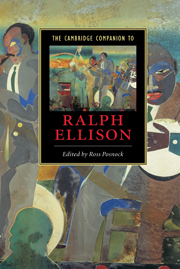Book contents
- Frontmatter
- Introduction
- 1 Ralph Ellison’s invented life
- 2 Ellison and the black Church
- 3 Ellison, photography, and the origins of invisibility
- 4 Ralph Ellison’s music lessons
- 5 Ralph Ellison’s constitutional faith
- 6 Ralph Ellison and the politics of melancholia
- 7 Invisible Ellison
- 8 Ellison’s experimental attitude and the technologies of illumination
- 9 Female iconography in Invisible Man
- 10 Chaos not quite controlled
- 11 Ralph Ellison, Hannah Arendt, and the meaning of politics
- 12 Dry bones
- Selected bibliography and suggestions for further reading
- Index
- Series List
12 - Dry bones
Published online by Cambridge University Press: 28 May 2006
- Frontmatter
- Introduction
- 1 Ralph Ellison’s invented life
- 2 Ellison and the black Church
- 3 Ellison, photography, and the origins of invisibility
- 4 Ralph Ellison’s music lessons
- 5 Ralph Ellison’s constitutional faith
- 6 Ralph Ellison and the politics of melancholia
- 7 Invisible Ellison
- 8 Ellison’s experimental attitude and the technologies of illumination
- 9 Female iconography in Invisible Man
- 10 Chaos not quite controlled
- 11 Ralph Ellison, Hannah Arendt, and the meaning of politics
- 12 Dry bones
- Selected bibliography and suggestions for further reading
- Index
- Series List
Summary
Presenting Bernard Malamud the Gold Medal for Fiction from the American Academy of Arts and Letters in 1983, Ralph Ellison spoke of him, a fellow ''minority'' artist, in terms characteristic of his own self-presentation: ''While remaining true to his own group's unique perception of experience, [the minority writer] is also goaded to add his individual voice to the futuristic effort of fulfilling the democratic ideal . . . sometimes in making his own segment of experience available to all he manages to reduce our social confusion to forms of lucid insight.'' Malamud calculated the advantage in similar terms. Being a minority can be a kind of ''lucky break'' for a writer, he argued at the height of Black Power, since his subject matter comes to him '''hot,' surcharged - call it the emotionalization of history.'' Although their collective experience might therefore provide African-Americans some artistic advantage, as it once did Jews, however, the risk for young writers is that they will produce ''little more than agit-propaganda.'' Placing Ellison at one end of the aesthetic spectrum and James Baldwin somewhere in the middle, Malamud asked about Leroi Jones (Amiri Baraka), ''what has he accomplished by hating half the human race?''
- Type
- Chapter
- Information
- The Cambridge Companion to Ralph Ellison , pp. 217 - 230Publisher: Cambridge University PressPrint publication year: 2005
- 1
- Cited by

